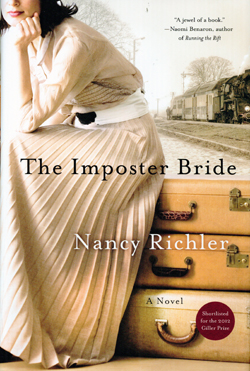The Imposter Bride by Nancy Richler, St. Martin’s Press, (c) 2013, ISBN 978-1-250-01006-4, 360 pages, $24.99
By Donald H. Harrison
 SAN DIEGO –Shortly after World War II, an Eastern European lady assumes the identity of a dead woman and agrees to travel to Canada to marry Sol Kramer. Once she gets there, however, for reasons he himself does not understand, he recoils from the arrangement, leaving her momentarily bereft. Then his younger brother Nathan gallantly steps in, and marries her, not suspecting she is an “imposter bride.”
SAN DIEGO –Shortly after World War II, an Eastern European lady assumes the identity of a dead woman and agrees to travel to Canada to marry Sol Kramer. Once she gets there, however, for reasons he himself does not understand, he recoils from the arrangement, leaving her momentarily bereft. Then his younger brother Nathan gallantly steps in, and marries her, not suspecting she is an “imposter bride.”
The Imposter Bride is not only a story of her deceit, but is also a story of loneliness and the human family’s search for meaning and context When her baby daughter Ruth is just an infant, the mysterious immigrant abandons her new family, her note saying only that she is sorry. She leaves behind a diary filled with the war-time reflections of the real Lily Azerov, whose identity she had appropriated.
After the shock of her departure wears off, Nathan, Sol, and their mother Bella do not speak of her much again– at least not in front of Ruth, her deserted child. When Sol marries Elka, the daughter of the real Lil’s cousin, Ida Pearl, everyone in the family grouping has some connection to the woman of mystery.
The false Lil keeps this memory alive, sending to Ruth rocks from different lakes across Canada — with no messages other than index cards telling where she collected the rock and the weather conditions.
As you would imagine, Ruth wonders about her mother, dreams about her, fantasizes about her, feeling that until she solves the riddle of her mother’s disappearance, she never will be a complete person.
Nina, a younger sister of Sol and Nathan, who for the most part is absent from the home, reflects that “our need to know where we come from, to connect to who we are and where we’re going {is} what makes us human, what sets us apart from all other animals.”
Not opposing thumbs? asks Ruth
“Monkeys also have opposing thumbs, my dear. It’s origins and destiny–our obsession with that. That’s what defines us.”
In this novel, we watch Ruth grapple with her need to know, her obsession. And we see that she is not so very different from Ida Pearl, Bella, and Elka — all of whom are plagued with questions of their own.
Sol and Nathan, on the other hand, are far less defined figures in this book. Author Richler seems far more concerned with exploring the female psyche — and that she does convincingly.
*
Harrison is editor of San Diego Jewish World. He may be contacted via donald.harrison@sdjewishworld.com